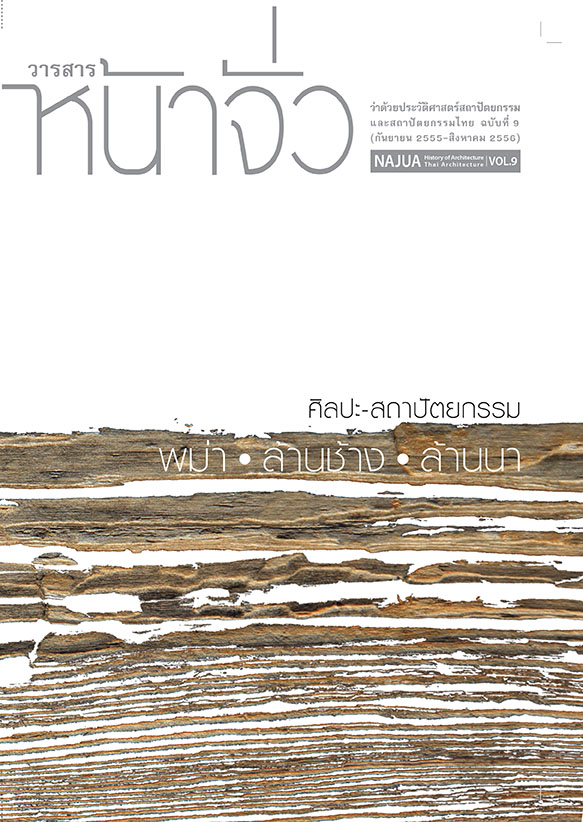ขอบเขตเรือนพื้นถิ่นในชุมชนน่าอยู่ : กรณีศึกษาหมู่บ้านลาวครั่ง ส่วนที่ 1 Boundaries of Dwellings in Livable Vernacular Community : Case Studies of Lao-Krang Villages Part 1
Main Article Content
Abstract
บทคัดย่อ
ท่ามกลางความเจริญที่เข้ามาในชุมชนหมู่บ้านพื้นถิ่นอย่างไม่ทันตั้งตัว ค่านิยมแบบตะวันตกและกระแสทุนนิยมที่ได้รับจากสังคมเมืองใหญ่ที่เจริญทางวัตถุอย่างรวดเร็ว ทำให้วิถีชีวิต ประเพณี วัฒนธรรมที่บ่งบอกถึงอัตลักษณ์ของชุมชนเปลี่ยนไป คนในชุมชนพื้นถิ่นในปัจจุบันกลับอาศัยอยู่แบบปัจเจกชนมากขึ้น มีการแบ่งขอบเขตเรือนอย่างชัดเจน โดยใช้วัสดุสมัยใหม่จากภาคอุตสาหกรรมที่สามารถหาได้ง่ายและติดตั้งสะดวก ทำให้คนในชุมชนละเลยความเป็นถิ่นที่ รูปแบบเฉพาะตัว และสัดส่วนขององค์ประกอบต่างๆ ของสถาปัตยกรรมที่เกิดจากมรดกภูมิปัญญาดั้งเดิมของชุมชน ที่ถ่ายทอดความรู้เชิงประสบการณ์ที่ได้บ่มเพาะคัดสรรมาแล้วจากรุ่นสู่รุ่น อีกทั้งผู้สืบเชื้อสายรุ่นหลังไม่เห็นความสำคัญที่จะรักษาไว้จากชุมชนพื้นถิ่นน่าอยู่ผู้คนพึ่งพาตนเองโดยใช้ประโยชน์จากสิ่งแวดล้อมที่มีอยู่ มีการดำรงชีวิตที่เข้าใจและอยู่ร่วมกับธรรมชาติในถิ่นที่ของตนอย่างไม่เบียดเบียนธรรมชาติมากนัก ผู้คนเอื้ออาทร เกื้อกูล แบ่งปัน ดูแลกัน บ้านแต่ละหลังในกลุ่มบ้านไม่มีรั้วกางกั้น เพื่อแบ่งเขตนอกเสียจากป้องกันจากฝูงวัวควายที่จะเข้าไปในเขตบ้าน หรือใช้เพียงวัสดุพื้นถิ่นที่หาได้ง่ายจากธรรมชาติมาทำเป็นรั้ว แต่มิได้ตัดขาดการมองเห็นและสามารถมีปฏิสัมพันธ์กับคนภายในชุมชนได้ และสามารถอยู่กันได้อย่างสงบสุขภายในชุมชน หากคนรุ่นหลังไม่สนใจที่จะดูแลรักษาความเป็นถิ่นที่และอัตลักษณ์ของชุมชนเอาไว้ ท้ายที่สุดชุมชนหมู่บ้านพื้นถิ่นที่มีอัตลักษณ์เฉพาะตน จะค่อยๆ เลือนรางหายไปกับกระแสวัตถุนิยม กลายเป็นเพียงหมู่บ้านจัดสรรทั่วๆ ไป ที่สามารถเห็นได้ บทความนี้มีจุดมุ่งหมายที่จะจำแนกประเภทและประโยชน์ของขอบเขตเรือนพื้นถิ่นในชุมชนลาวครั่ง เพื่อสร้างสรรค์ชุมชนน่าอยู่ โดยนำเสนอแนวคิดจากกรณีศึกษาบ้านกุดจอก จังหวัดชัยนาท และบ้านเชียงแมน บ้านท่าม่วง บ้านซ่างไห บ้านปากอู และบ้านปากซี ในหลวงพระบาง
Abstract
The rapid development and adoption of western lifestyle and capitalism cause the transformations of the lifestyles, traditions, and cultures of vernacular communities that indicate their identities. At present, people in such communities live more individually and designate their property boundaries explicitly by using new materials from industrial sector which can be obtained conveniently and easily assemble. As a result, people overlook their own inherited local wisdoms obtained from experiential knowledge such as their senses of place, architectural styles, and built environments that have been carefully selected and passed through generations. Furthermore, the preservation of their own indigenous and distinctive identities has not been treasured by younger generations. In livable vernacular communities, the residences look after each other and live on local resources with minimal exploits of and impact to their natural environments. The majority of houses in vernacular villages do not have fence or only use local and natural materials that can be acquired around their communities to designate their property boundaries and to protect their properties from cattle. Their visions are not blocked in by the fences. Villagers still have interrelationship between themselves and live peacefully in the communities. If the younger generations had not realized to preserve and treasure how special and unique their vernacular villages’ identities were, these indigenous communities would have been vanished and transformed into general modern housing developments abundantly seen in large cities. The purpose of this paper is to differentiate types and purposes of the boundaries of Lao Krang ethnic’s vernacular dwellings at Ban Kudjok in Chainat province, Thailand and in Ban Xiengman, Ban Ta Maung Keo, Ban Xanghai, Ban Pak Xi, and Ban Pak Ou in Luang Prabang, Laos in order to present the concept of livable dwellings deriving from these case studies.

